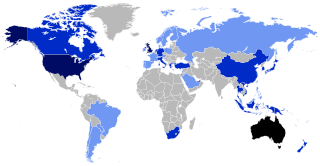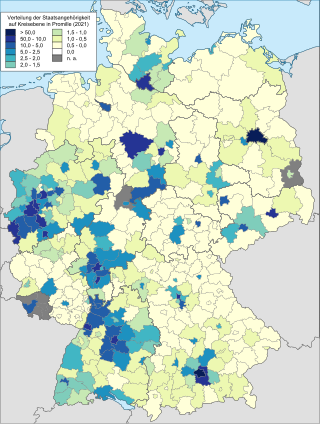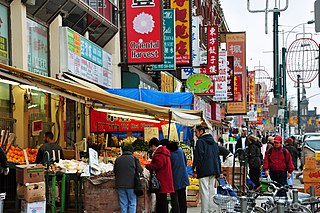| Total population | |
|---|---|
| c. 12,000 [1] (2018) | |
| Regions with significant populations | |
| Copenhagen | |
| Languages | |
| Chinese, Danish | |
| Related ethnic groups | |
| Overseas Chinese, Chinese diaspora |
Chinese people in Denmark form one of the smaller and less-studied Chinese diaspora communities of Europe. [2]
The earliest Chinese migrants in Denmark are believed to have been 34 men from Guangdong who came to the famous Tivoli Gardens amusement park in 1902 as travelling performers on contracts for the summer. Though the initial understanding was that they would return to China after their work had ended, half found other employment at the end of their contracts, and thus chose to settle down in Denmark. [3] Similar forms of "coincidental arrival" would continue over the next few decades: some sailors jumped ship in Denmark or became stranded there during the 1904-05 Russo-Japanese War and later World War I, a few itinerant soapstone traders arrived from Qingtian, Zhejiang and ended up staying in the country, and other similar cases. By 1949, a total of 43 Chinese are believed to have become immigrants in Denmark; most of these were male, and among them were just four women married to Danish men. [4] Early immigrants maintained few community links to each other or to their ancestral land, and thus were quickly assimilated into Danish society. [4] After the 1949 establishment of the People's Republic of China, many deliberately cut off their contacts with relatives in China in fear that those relatives might suffer persecution for having foreign contacts. [5]
Up until the 1970s, immigration from China remained almost non-existent, even as growth in the Danish economy created labour shortages and immigrants from other parts of the world flowed into the country. Police statistics showed 113 people from mainland China living in Denmark as of 1969, and one researcher estimates perhaps 60 more from Hong Kong, Taiwan, and Singapore. [5] The numbers of migrants did not reach a significant level until the 1980s and 1990s, just as Danish immigration laws were becoming more strict. [6] By 1996, there were 3,467 migrants/descendants of migrants from mainland China, Hong Kong, Singapore, and Taiwan. [7] These years were also marked by a shift in the gender balance of migrants, with increasing numbers of women. [2]
Asylum seekers from the People's Republic of China are not prevalent among Chinese migrants to Denmark, despite the fact that Denmark has one of Europe's lowest rejection rates for asylum claims; such migrants prefer other countries in Southern, Central, or Eastern Europe, due to the better opportunities for work there. This contradicts claims that Chinese migrants are attracted by Denmark's generous social welfare benefits. [8]
Statistics Denmark showed 9,799 people born in mainland China and 448 born in Taiwan living in Denmark as of October 2009 [update] . [1]
Statistics Denmark showed in the first quarter of 2018 that 11,710 people with origins in mainland China are living in Denmark legally.
Though early Chinese migrants consisted largely of travelling artists and merchants, after World War II, migrants concentrated increasingly in the Chinese restaurant business. [5] Copenhagen's first Chinese restaurant, the China House, was opened by a Chinese migrant from the Netherlands who had remigrated to Denmark; four more restaurants opened up in the 1950s, and five more in the 1960s. [9] The format of restaurants changed in the 1970s, with more grill bars. Other Chinese, even if not directly involved in the restaurant trade, were somehow involved with food in the ethnic economy; for example, the first ethnic Chinese graduate of a Danish university opened a soy sauce factory in 1957. [10] However, the restaurant sector began to reach saturation in the 1980s; new migrants thus set up businesses in other sectors, including travel agencies, traditional Chinese medicine clinics, and import-export firms. [11]
In 2004, 60,000 Chinese tourists visited Denmark; this number is at least projected to quadruple by 2020. [12] The 200th anniversary of the birth of Hans Christian Andersen was a major draw for Chinese tourists to come to Denmark, as he is a major icon of Danish culture in China; however, tourists who came at that time were disappointed to find little attention devoted to him in Copenhagen. As a result of feedback from Chinese tourists, a new museum devoted to him was opened at the town hall square. [13]
The desire by tourism authorities to attract Chinese tourists conflicts with the fears from some other government bureaux that tourism from China will become an inlet for increasing numbers of illegal immigrants. But, many Chinese travel agencies require a RMB50,000 deposit from prospective tourists to Denmark, in order to protect themselves against the penalties which may be assessed against them by the Danish government if tourists they bring to the country do not depart on time. [14] The influx of Chinese tourists has also caused some more discussions, especially with regards to sex tourism; many male Chinese tourists seek out strip clubs, but are usually disappointed with the number of Asian women found in these clubs instead of the expected Danish women. [15]
Alexandra, Countess of Frederiksborg was born in Hong Kong of mixed European and Chinese ancestry. In 1995 she married Prince Joachim of Denmark. Their two children, Prince Nikolai (born 1999) and Prince Felix (born 2002), are the first members of the Danish Royal Family to have Chinese descent.
Right of abode in Hong Kong entitles a person to live and work in the territory without any restrictions or conditions of stay. Someone who has that right is a Hong Kong permanent resident. Foreign nationals may acquire the right of abode after meeting a seven-year residency requirement and are given most rights usually associated with citizenship, including the right to vote in regional elections. However, they are not entitled to hold territorial passports or stand for office in some Legislative Council constituencies, unless they also naturalise as Chinese citizens.
Chinatowns in Latin America developed with the rise of Chinese immigration in the 19th century to various countries in Latin America as contract laborers in agricultural and fishing industries. Most came from Guangdong Province. Since the 1970s, the new arrivals have typically hailed from Hong Kong, Macau, and Taiwan. Latin American Chinatowns may include the descendants of original migrants — often of mixed Chinese and Latino parentage — and more recent immigrants from East Asia. Most Asian Latin Americans are of Cantonese and Hakka origin. Estimates widely vary on the number of Chinese descendants in Latin America but it is at least 1.4 million and likely much greater than this.

Chinese Australians are Australians of Chinese origin. Chinese Australians are one of the largest groups within the global Chinese diaspora, and are the largest Asian Australian community. Per capita, Australia has more people of Chinese ancestry than any country outside Asia. As a whole, Australian residents identifying themselves as having Chinese ancestry made up 5.5% of Australia's population at the 2021 census.

During the British colonial era, English was the sole official language until 1978. Today, the Basic Law of Hong Kong states that English and Chinese are the two official languages of Hong Kong. All roads and government signs are bilingual, and both languages are used in academia, business and the courts, as well as in most government materials today.

Chinese nationality law details the conditions by which a person holds nationality of the People's Republic of China (PRC). The primary law governing these requirements is the Nationality Law of the People's Republic of China, which came into force on September 10, 1980.

Chinese New Zealanders or Sino-New Zealanders are New Zealanders of Chinese ancestry. The largest subset of Asian New Zealanders, many of the Chinese immigrants came from Mainland China, Hong Kong, Taiwan, or other countries that have large populations of Chinese diaspora. Today's Chinese New Zealand group is also composed of diasporic communities from Indonesia, Malaysia, Cambodia, Vietnam and Singapore. As of 2018, Chinese New Zealanders account for 4.9% of the population of New Zealand, and are the largest Asian ethnic group in New Zealand, accounting for 36.3% of Asian New Zealanders.
Chinois, also referred to by the Réunion Creole name Sinwa or Sinoi, are ethnic Chinese residing in Réunion, a French overseas department in the Indian Ocean. As of 2000, roughly 25,000 or more lived on the island, making them one of the region's largest Chinese communities along with Chinese South Africans, Chinese people in Madagascar, and Sino-Mauritians.

Birth tourism is the practice of traveling to another country or city for the purpose of giving birth in that country. The main reason for birth tourism is to obtain citizenship for the child in a country with birthright citizenship. Such a child is sometimes called an "anchor baby" if their citizenship is intended to help their parents obtain permanent residency in the country. Other reasons for birth tourism include access to public schooling, healthcare, sponsorship for the parents in the future, hedge against corruption and political instability in the children’s home country. Popular destinations include the United States and Canada. Another target for birth tourism is Hong Kong, where some mainland Chinese citizens travel to give birth to gain right of abode for their children.

The Exit & Entry Permit for Taiwan, Republic of China is the document for the bearer to enter into and/or depart from the Taiwan Area, namely Taiwan, Penghu, Kinmen and Matsu. Currently, there are several types of Exit & Entry Permit that reflect the bearer's residency status. The permit is issued by the National Immigration Agency of the Republic of China (Taiwan). For different purposes, the permit is also known as:

The People's Republic of China passport is a passport issued to citizens of the People's Republic of China for the purpose of international travel, and entitles its bearer to the protection of China's consular officials overseas.

Australians, colloquially known as Aussies, are the citizens, nationals and individuals associated with the country of Australia. This connection may be residential, legal, historical or ethno-cultural. For most Australians, several of these connections exist and are collectively the source of their being Australian. Australian law does not provide for a racial or ethnic component of nationality, instead relying on citizenship as a legal status.

The visa policy of Hong Kong deals with the requirements in which a foreign national wishing to enter Hong Kong through one of the 15 immigration control points must meet to obtain an entry permit or Visa, which depending on the traveller's nationality, may be required to travel to, enter, and remain in the Hong Kong Special Administrative Region. Visitors from over 145 countries are permitted without Visa entry for periods ranging from 7 to 180 days, to the Hong Kong Special Administrative Region for tourism or certain business-related activities. All visitors must hold a passport valid for more than 1 month.

Chinese people in Germany form one of the smaller groups of overseas Chinese in Europe, consisting mainly of Chinese expatriates living in Germany and German citizens of Chinese descent. The German Chinese community is growing rapidly and, as of 2016, was estimated to be around 212,000 by the Federal Institute for Population Research. In comparison to that, the Taiwanese OCAC had estimated there were 110,000 people of Chinese descent living in Germany in 2008.
Hongkongers, Hong Kongers, Hong Kongese, Hongkongese, Hong Kong citizens and Hong Kong people are demonyms that refer to the resident of Hong Kong, although they may also refer to others who were born and/or raised in the territory.
Chinese people in the Netherlands form one of the largest overseas Chinese populations in continental Europe. In 2018 official statistics showed 92,644 people originating from the People's Republic of China (PRC) and Republic of China (ROC), or people with at least one such parent. However, these statistics do not capture the whole size of the Chinese community, which since its earliest days has included not just migrants from China, but people of Chinese ethnicity drawn from among overseas Chinese communities as well.
With the establishment of the People's Republic of China in 1949, American immigration policy towards Chinese emigrants and the highly controversial subject of foreign policy with regard to the PRC became invariably connected. The United States government was presented with the dilemma of what to do with two separate "Chinas". Both the People's Republic of China and the Republic of China wanted be seen as the legitimate government and both parties believed that immigration would assist them in doing so.
Mainland Chinese or mainlanders are Chinese people who live in or have recently emigrated from mainland China, defined as the territory governed by the People's Republic of China (PRC) except for Hong Kong, Macau, and the partly-PRC-controlled South China Sea Islands, and also excluding certain territories that are claimed by the PRC but not controlled, namely Taiwan a.k.a. the "Republic of China" (ROC), which is a state with limited recognition, and other associated territories that are ruled by Taiwan. The term also refers to historical groups of people of Chinese origin who immigrated to Hong Kong, Macau and Taiwan during the 20th century, especially in the context of specific historical events.

The Chinese Canadian community in the Greater Toronto Area was first established around 1877, with an initial population of two laundry owners. While the Chinese Canadian population was initially small in size, it dramatically grew beginning in the late 1960s due to changes in immigration law and political issues in Hong Kong. Additional immigration from Southeast Asia in the aftermath of the Vietnam War and related conflicts and a late 20th century wave of Hong Kong immigration led to the further development of Chinese ethnic enclaves in the Greater Toronto Area. The Chinese established many large shopping centres in suburban areas catering to their ethnic group. There are 679,725 Chinese in the Greater Toronto Area as of the 2021 census, second only to New York City for largest Chinese community in North America.

East Asian Canadians are Canadians who were either born in or can trace their ancestry to East Asia. East Asian Canadians are also a subgroup of Asian Canadians. According to Statistics Canada, East Asian Canadians are considered visible minorities and can be further divided by on the basis of both ethnicity and nationality, such as Chinese Canadian, Hong Kong Canadian, Japanese Canadian, Korean Canadian, Mongolian Canadian, Taiwanese Canadian, or Tibetan Canadian, as seen on demi-decadal census data.
Controls imposed on internal borders within a single state or territory include measures taken by governments to monitor and regulate the movement of people, animals, and goods across land, air, and maritime borders through border controls.
{{citation}}: CS1 maint: location missing publisher (link)